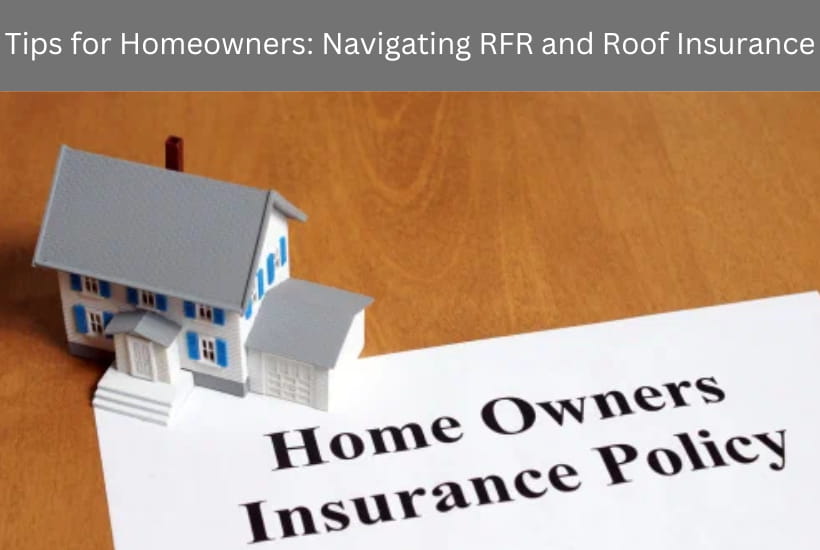In the context of California roof insurance coverage, RFR frequently refers to “reason for replacement” or “reason for repair.” This phrase, which refers to the explanation given for fixing or replacing a roof, is crucial when discussing insurance claims and coverage. A thorough understanding of RFR entails investigating its effects on homeowners and insurers, as well as its consequences in the insurance process and the situations that call for its use. This comprehensive reference explores RFR, providing information on its definition, applicability, and significance in the context of California’s roof insurance market.
Definition and Relevance of RFR
What Does RFR Stand For?
- Reason for Replacement (RFR): This refers to the justification provided when a roof needs to be replaced due to specific conditions, such as damage, deterioration, or other valid reasons.
- Reason for Repair (RFR): Similar to a replacement, this refers to the rationale behind repairing a roof instead of opting for a complete replacement.
RFR is an essential term in the context of roof insurance claims. When homeowners file a claim for roof damage, insurers evaluate the RFR to determine the scope of coverage and the appropriate course of action—whether repair or replacement.
Why Is RFR Important?
RFR serves several purposes:
- Claims Assessment: Insurance companies use the RFR to assess whether the claim is valid and aligns with policy terms.
- Cost Management: It helps insurers decide whether repairs are sufficient or if a full replacement is necessary, balancing cost-effectiveness with coverage obligations.
- Regulatory Compliance: In California, roofing repairs and replacements must comply with state laws, building codes, and environmental regulations. The RFR ensures that claims meet these standards.
- Policyholder Protection: By documenting the RFR, homeowners have a clear understanding of why their claim was approved or denied, fostering transparency.
Common Reasons for Replacement or Repair (RFR)

Several factors can lead to the need for roof repair or replacement. Insurance companies evaluate these reasons carefully to determine coverage eligibility. Below are the most common RFR scenarios:
- Weather-Related Damage
California’s diverse climate poses various challenges to roofs. Severe weather events, such as storms, hail, or strong winds, can cause significant damage.
- Storm Damage: High winds may lift or displace shingles, while heavy rain can lead to leaks or water damage.
- Hail Damage: Hailstones can crack tiles, dent metal roofs, or damage shingles, reducing their effectiveness.
- Wildfires: In regions prone to wildfires, roofs may sustain heat or ember damage, compromising structural integrity.
- Age-Related Deterioration
Roofs have a finite lifespan, typically ranging from 20 to 50 years depending on the material (e.g., asphalt shingles, clay tiles, metal). Over time, wear and tear makes roofs less effective at protecting homes. Age-related issues include:
- Cracked or missing shingles: indicating the roof’s inability to provide adequate protection.
- Sagging Rooflines: suggesting structural weakness due to prolonged exposure to the elements.
Maintenance Neglect
While insurance may cover sudden or accidental damage, neglecting routine maintenance can lead to problems that are often excluded from coverage:
- Blocked gutters: Allowing water to pool on the roof, causing leaks or rot.
- Moss Growth: Leading to water retention and deterioration of roofing materials.
- Building Code Compliance
California’s stringent building codes and regulations require roofs to meet specific standards. Older roofs may not comply with current codes, necessitating updates during repair or replacement. This is especially relevant in areas prone to earthquakes or wildfires.
- Prevention of Further Damage
Insurers may approve repairs or replacements to prevent minor issues from escalating into major structural problems. For example:
- Small Leaks: If left unattended, these can cause significant water damage or mold growth.
- Cracked flashing: protects the seams around chimneys, vents, or skylights and must be repaired to avoid leaks.
The Insurance Process and RFR
- Filing a Claim
When a homeowner experiences roof damage, the first step is to file a claim with their insurance provider. The claim should include:
- Detailed descriptions of the damage.
- Photographic evidence.
- Any relevant documents, such as repair estimates or contractor reports.
- Inspection and Assessment
After a claim is filed, the insurer typically sends an adjuster to inspect the roof. During this inspection, the adjuster evaluates:
- Extent of the Damage: Determining whether repair or replacement is needed.
- Cause of the Damage: Establishing the RFR, such as storm damage, age, or neglect.
- Policy Coverage: ensuring the claim aligns with the homeowner’s policy terms.
Coverage Determination
Based on the RFR, the insurer decides whether to approve the claim and what portion of the cost they will cover. This determination is influenced by:
- Policy Type: Some policies offer full replacement cost coverage, while others only cover actual cash value (depreciated value).
- Deductible: The homeowner’s out-of-pocket cost before insurance coverage kicks in.
- Exclusions: Certain causes of damage, such as gradual wear and tear, may not be covered.
- Repairs or Replacement
Once the claim is approved, the homeowner can proceed with repairs or replacement. Insurers may require the use of licensed contractors to ensure compliance with building codes.
Challenges and Considerations in California
- Wildfire Risk
California’s high wildfire risk poses unique challenges for roof insurance coverage. Insurers may deny claims if the RFR indicates poor maintenance or the use of non-fire-resistant materials. To mitigate risks:
- Homeowners should use fire-resistant roofing materials like metal or clay tiles.
- Regular inspections can identify vulnerabilities.
- Environmental Regulations
California’s environmental laws may impact roofing repairs or replacements. For instance:
- Cool roof Requirements: Certain areas mandate the use of reflective materials to reduce energy consumption.
- Recycling Old Materials: The disposal of roofing debris must adhere to environmental guidelines.
- Rising Insurance Costs
In recent years, homeowners in California have faced rising insurance premiums due to increased natural disasters. Understanding the RFR can help homeowners:
- Negotiate better terms with insurers.
- Avoid claim denials by maintaining their roofs.
Tips for Homeowners: Navigating RFR and Roof Insurance

- Maintain Your Roof
Regular maintenance can prevent damage and improve your chances of a successful insurance claim. Key steps include:
- Cleaning gutters to prevent water damage.
- Inspecting for missing or damaged shingles.
- Scheduling professional roof inspections annually.
- Understand Your Policy
Review your insurance policy to understand what is covered and excluded. Pay attention to:
- Coverage limits for roof repairs or replacements.
- Specific exclusions, such as wear and tear or neglect.
- Requirements for filing a claim, such as reporting damage promptly.
- Work with Licensed Contractors
Using licensed and experienced roofing contractors ensures quality repairs that comply with California’s building codes. Insurers may require proof of licensure for claims approval.
- Document Everything
When filing a claim, thorough documentation is critical. Keep records of:
- Repair estimates and invoices.
- Communication with your insurer.
- Photographs of the damage before and after repairs.
Conclusion
In California, the phrase RFR (Reason for Replacement or Reason for Repair) is crucial to roof insurance coverage. It provides the foundation for assessing claims, figuring out coverage, and choosing the best line of action. Homeowners can better manage the insurance process and safeguard their investments by being aware of the elements that affect RFR, such as weather damage, age-related wear, or building code compliance. To effectively handle roof problems and provide sufficient coverage, proper maintenance, unambiguous paperwork, and a deep comprehension of insurance plans are necessary.

